How Does a Geothermal Heat Pump Work?
If you have ever done basic research into Geothermal systems, you might have wondered what makes these systems so efficient, practical, and environmentally friendly? The root to all of these benefits is the heat pump. Using basic physics, heat pumps can harness the solar energy stored in the ground and transfer it to your home. Unlike conventional gas furnaces that produce heat by burning fuel, Heat pumps don’t produce their own heat but rather allocate it from the ground. This makes heat pumps extremely efficient, producing $4 worth of energy for every $1 spent running the pump. Compare that to conventional gas furnaces that produce $.65 of energy for every $1 spent running the furnace, and it is easy to see why geothermal heat pumps big news in the global green energy market.
The mechanics behind heat pumps is actually fairly easy to understand. Let us look at the individual parts that comprise a heat pump system so we can get a grasp for how it works.
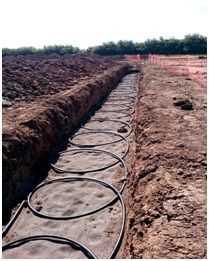
Installing a Geothermal loop
Geothermal Loop system
Refrigerant Loop System (The Heat Pump)
It is important to understand that a heat pump system is comprised of three heat transfer loop systems that don’t physically come into contact with each other but interact with each other through the heating/cooling of metal barriers separating each loop. 1. The geothermal heating loop 2. The forced air heating loop. 3. The refrigerant loop. The Geo loop and Air loop are easy to understand as heat is transferred by surface contact. So, let’s study the 3rd refrigeration loop. This refrigerant contains Freon which has a very low boiling point when under pressure, and by changing its pressure we can change its state from liquid to gas. By doing so the low temperature energy collected from the ground can be concentrated in the heat pump and come out at 30-40 C in the load baring loop (forced air loop). Let’s discuss all the individual parts that make up the heat pump loop and hopefully that will give us a better understanding of how the heat pumps turn cold water into 30-40 C hot air.
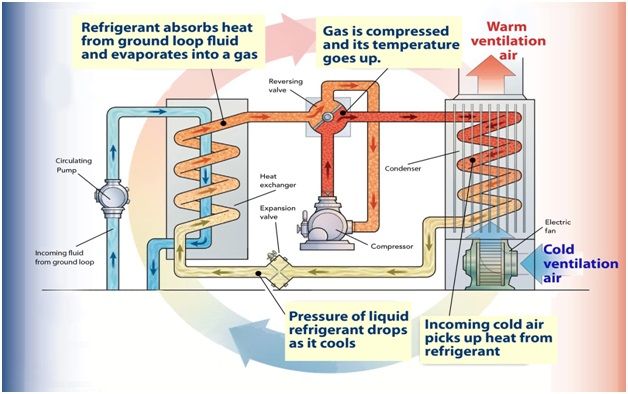
The heat pump system (air space heating form)
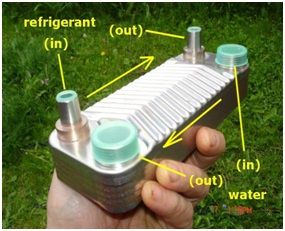
Heat Exchanger
The Evaporator Heat Exchanger
The first place the energy from the geothermal loop meets the heat pump loop is the evaporator. The evaporator is a heat exchanger that works on the same principles as a car radiator. The warmed ground loop water enters the evaporator and transfers its energy to the refrigerant by warming up metal plates that separate the refrigerant and the water. Remember that each loop is a closed system. In figure 3 it might appear that the water and refrigerant mix, but they are completely separated by metal plates in the exchanger. Although the ground loop water is not very hot, the low boiling temperature of the refrigerant means that even the relatively low temperature of the ground loop is enough to turn the liquid refrigerant into a gas state (hence the name evaporator). Like water, which boils at 100 C, Freon’s properties are such that it boils at as low as zero degrees C.
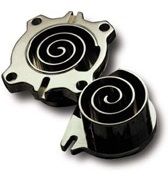
Scroll compressor
The Compressor
The compressor is one of the fundamental components of the heat pump. It is comprised of two parts, the motor that turns the compressor, and the scroll compressor that compresses the refrigerant (see figure 4). The refrigerant enters the compressor in a gaseous state after being warmed by the ground water at around 2-3 degrees C at 50 PSI and leaves the compressor at around 60-70 degrees C at 250 PSI. You might be wondering how the compressor was able to heat the refrigerant so drastically, but in reality, the compressor doesn’t heat anything at all. The gas that exits the compressor has the exact same amount of energy as the gas that entered, what changed is the volume. By reducing the volume, the temperature rises as the same amount of energy is found in a smaller space causing its temperature increases. Physics explains that this temperature increases is the result of the molecules being denser thus more collisions.
The Condenser Heat exchanger
The condensing heat exchanger works in the exact opposite way as the evaporator. The hot gas from the compressor enters this heat exchanger and interacts with the load baring loop. The air in the house is circulated across this heat exchanger and absorbs the thermal energy of the refrigerant (again the two systems never physically touch and are separated by layers of metal plates). Since the energy is absorbed from the refrigerant, the refrigerant cools down as it continues through the heat pump loop. The condenser and the evaporator do opposite things but are mechanically identical.
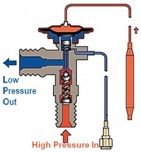
Expansion valve
The Expansion Valve
The last component the refrigerant passes through before it repeats the cycle is the expansion valve. Basically, this valve depressurizes the refrigerant, turning it back into a liquid state so it can re-enter the evaporator and be warmed up by the energy absorbed through the ground loop again.
The Reversing Valve (used when both Heating and Cooling)
The last component making up the heat pump that we will discuss is the reversing valve. If you look at figure 2 carefully you will notice that when the reversing valve is closed the warmed gas that usually enters the compressor at the entrance port would enter through the exit port. What activating the reversing valve does is decompress the refrigerant and reverse the condenser and evaporator’s functionality. You would do this in the summer months to use the heat pump as a substitute for air conditioning. Instead of carrying hot gas to the condenser which would warm your home when a fan blows air over the coil the compressor would decompress the gas and send cold refrigerant to a coil located in an air duct thus cooling down your house when air is blown over coil. This is possible because the ground maintains a temperature around 45- 55 degrees C during the summer and winter, so in the winter the ground is warmer than the outside air and in the summer the ground is colder than the outside air.



